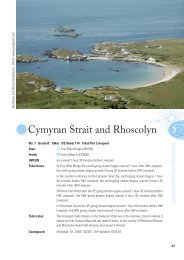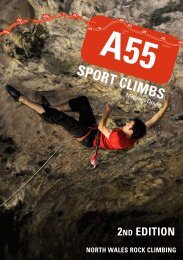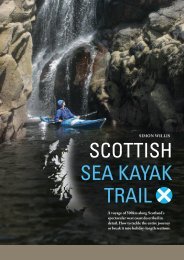Gairloch - Scottish Rock Volume 2 - Pesda Press
Gairloch - Scottish Rock Volume 2 - Pesda Press
Gairloch - Scottish Rock Volume 2 - Pesda Press
Create successful ePaper yourself
Turn your PDF publications into a flip-book with our unique Google optimized e-Paper software.
<strong>Gairloch</strong><br />
129<br />
W.Blackwood in 1957. The most notable route of this<br />
era was O’Hara and George Fraser’s ascent of Dragon,<br />
breaching the impressive capping roof in the centre of<br />
the Upper Wall in a stunning position. Many other strong<br />
teams made the long trek in throughout the sixties. The<br />
formidable duo of Dougal Haston and Robin Smith paid a<br />
visit in 1960, resulting in Gob. In the late sixties, Creagh<br />
Dhu climbers visited, resulting in Balaton from Con<br />
Higgins and W.Gorman, and Abomination, from John<br />
McLean, John Cunningham and J.Currey. Geoff Cram and<br />
Roloff Schipper added the impressive St George, while<br />
Dick Isherwood and Eddie Birch had a productive day<br />
with The Sword, their third new route. The following year<br />
the much-eyed though often wet line of Carnmore Corner<br />
fell to Rab Carrington and John Jackson.<br />
Tom Patey and Mike Galbraith recorded the first route on<br />
Tollie Crag in 1966 with The Handrail. Patey also climbed<br />
on both Jetty Buttress and Goat Crag, accounting for<br />
some of the earlier routes. At Tollie others soon followed,<br />
including Chris Jackson and B. Andrews with The Trip,<br />
John Cunningham and Bill March with Stony Broke, and<br />
Gudgeon from Jackson and Tom Proctor. A variety of<br />
teams produced further routes on the Bonaid Dhonn but it<br />
was Cunningham and March who added two of the best<br />
lines in 1971 with Vertigo and The Creep. Throughout the<br />
early seventies various Joint Services Mountain Training<br />
Centre personnel based at Dundonnell developed Jetty<br />
Buttress and added some lines on Goat Crag but the<br />
SMC Journal new climbs editor neglected to record<br />
them. Around the same time, Pete Botterill & Jeff Lamb<br />
climbed the very fine The Bug on Upper Tollie Crag with a<br />
tension traverse near the top.<br />
Carn Mor was brought into the eighties with Dougie<br />
Mullin’s impressive on-sight lead of the immaculate<br />
left wall of Carnmore Corner. At E4 6a, Wilderness<br />
was one of the hardest on-sights in the country at the<br />
time. Dougie Dinwoodie took over as the main activist<br />
throughout the eighties, his first significant contribution<br />
the wonderfully situated pitch of The Orange Bow. A<br />
productive trip with Graeme Livingston the following<br />
year produced, over three days, no less than four major<br />
additions to the Upper Wall including the sustained Lion<br />
Rampant together with the impressively steep exposed<br />
slanting roof of Death-Wolf, lead by Livingston. Climbing<br />
with Andy Nisbet, Dinwoodie later added many other<br />
lines in the area while checking out the crags for the<br />
last SMC guide, including Jivaro Crack and The Red<br />
Crack either side of Carnmore Corner, together with a<br />
hard Left-Hand Start to his own route The Orange Bow.<br />
In the late nineties, Gary Latter climbed the surprisingly<br />
neglected Carnmore Corner Direct, Tim Rankin and Guy<br />
Robertson bringing things up to date in 2000 with the<br />
finely positioned Fian Grooves.<br />
Raven’s Crag, near <strong>Gairloch</strong> was developed throughout<br />
the early eighties by locally based Steve Chadwick and<br />
friends, Doug Lang later filling in some of the gaps.<br />
Around the same period, more of the obvious lines on<br />
Tollie Crag succumbed, Murray Hamilton climbing the<br />
obvious arêtes at either end of the crag, and with Rab<br />
Anderson added Decadent Days. Dougie Dinwoodie<br />
added the two hardest routes on the crag with Rain in<br />
the Face and Each Uisge, while Anderson, climbing with<br />
either Chris Greaves or Grahame Nicoll, cleaned up on<br />
most of the remaining lines, including a free ascent<br />
of Gudgeon, and first ascents of North West Orient<br />
and Gulf Coast Highway. Anderson also added The<br />
Heretic on the Upper Crag, Kev Howett later creating an<br />
independent start with Heresy. Further down the loch<br />
around the same time (1987), the impressive front face<br />
on Loch Maree Crag saw its first routes from Howett,<br />
with four impressive extremes on the overhanging front<br />
face, culminating in the airy and sustained arête Spirit<br />
Air, together with the hard and committing Jarldom<br />
Reach. Howett later returned in the early nineties to<br />
produce two further worthy additions, including the<br />
excellent Arial, in addition to adding The Shimmer to<br />
White Wall Crag.<br />
In 1994 a number of crags around Gruinard Bay were<br />
developed, mainly by John Mackenzie in the company of<br />
either Graham Cullen or Bob Brown, producing almost 30<br />
routes from Difficult-E3, with Gruinard Crag and Lochan<br />
Dubh Crag being particularly significant discoveries.<br />
The following year others visited, with Martin Moran<br />
on-sighting Call of the Wild up the left side of the






